
40-assets-for-youth
40 Assets for Youth
The 40 Developmental Assets for Youth are the work of the Search Institute (www.search-institute.org). They are 40 research-based positive experiences and qualities that influence young people’s development, helping them become caring, responsible, and productive adults. I had worked with them since the early days when they were first released, and there were 30 of them initially. In 2004, the data represented 217,277 youth in grades 6 through 12 in public and alternative schools from 318 U.S. towns and cities who took the survey during the 1999-2000 school year.
Today it grows out of years of research with millions of young people and is based on the Developmental Assets framework. “They are building blocks for raising healthy children and youth” (Search Institute, 2009).
Their research has shown that the more assets that kids have, the less likely they are to engage in risky behavior and the more likely to thrive. The 40 assets are grouped into two categories of four, representing broad domains of influence in young people’s lives: support, empowerment, boundaries and expectations, and constructive use of time are all external assets. These are the relationships and opportunities that adults provide.
Internal Assets represent a commitment to learning, positive values, social competencies, and positive identity. These are competencies and values that youth develop internally that help them become self-regulating adults.
Using the Search Institute’s Profiles of Student Life survey, this 156 item survey is available for 6th-12-grade students in public and private schools. It measures the 40 developmental assets that youth report in a self-reporting manner. As an educator, I noticed some students in stressful situations seem to thrive still, while others struggle with all of the distractions that life can offer. I wondered for years why some were better than others. I believe that the 40 Development Assets for Youth serve as a significant part of the answer. In the following two blogs, I will outline the External Assets and Internal Assets.
Meanwhile, if you would like to download a copy of the assets, head on to Home | Search Institute, click on the “Tools and Resources” tab at the top, and in the pull-down menu, click on “Free Downloads.” There you will find a copy of the assets by age level. There are four lists, which are related but vary according to the developmental level of the child.
Here is a link to the Assets for Youth – Dr. Rich Patterson (pattersonphd.com)
Here is the link to the Search Institute’s wonderful material Home | Search Institute
Please continue to read the following two blogs, where I will continue discussing this critical research.
Yours for a Better Life,
Rich

Let’s Connect!